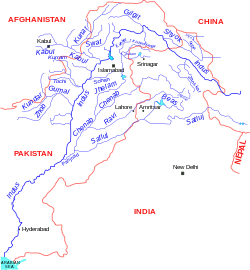India
In Srinagar, most of the city areas were submerged under water. The river Jhelum spilled over submerging Sonwar Bagh, Shivpora, [15] Batwara, Soitang, Lasjan, Padshai bagh, Natipora, Pandrathan, LalChowk, Rajbagh, Jawahar Nagar, Gogji Bagh and Wazir Bagh neighbourhoods of city. The first and the second storey of the houses and hotels in Rajbagh that were packed with tourists were submerged. [16] According to Omar Abdullah, the Chief Minister of Jammu and Kashmir then, boats had been brought from Delhi to help with evacuations, and the air force had begun rescue operations in the city. [17]
50 bridges were reported to have been damaged across the state. The preliminary assessment of damages to property was estimated between INR 5000 cr to INR 6000 cr. The state government requested the central government for 25,000 tents and 40,000,000 blankets for the affected people. [10] There was a total estimated loss of 1 trillion INR to Kashmir division alone.
In the Jammu Division, landslides triggered by heavy rainfall had damaged roads, dozens of bridges, buildings and crops. Vehicular traffic had been stopped on the Jammu-Pathankot highway. Katra-bound trains were halted. Haj flights scheduled up to 12 September were postponed. [18] The Jammu-Pathankot national highway was opened on 8 September, after the water level receded. [19] Srinagar-Leh Highway reopened for traffic on 9 September. [20] The Prime Minister of India Narendra Modi called it a "national calamity".
Pakistan
Flow of destruction as flood water entered Multan villages. While the Trimmu Head works was saved from the peak flood discharge, more than 350 villages in Jhang District were flooded due to the breaches made at two places in Athari Hazari dyke, leaving trail of destruction behind. As the floodwater moved further south, water level started increasing at Panjnad and had reached 116,000 cusecs, flooding areas in Mittan Kot and 300 villages in Multan District. National Disaster Management Authority (NDMA) said that 257 people had been killed and more than 1.1 million were affected by the floods. [21] [22] According to reports, the Trimmu Head works, safely discharged 650,000 cusecs of water resulting in the water levels to recede. Three people were reported killed in Jhang and nine in Chiniot. [22]



